 Indians Archive
Indians Archive  Cleveland Sports Vault: Pondering a Ripley’s Indians Believe-It-Or-Not® Museum, Part II
Cleveland Sports Vault: Pondering a Ripley’s Indians Believe-It-Or-Not® Museum, Part II
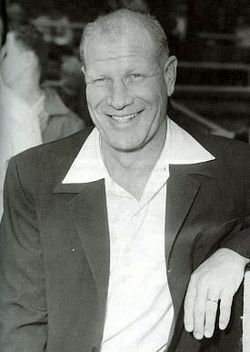 Last week, we began to consider items that might fill a Ripley’s-type museum full of Tribe-related artifacts. We are going to keep the stream of consciousness going.
Last week, we began to consider items that might fill a Ripley’s-type museum full of Tribe-related artifacts. We are going to keep the stream of consciousness going.
The rules for our museum are simple. We’re stocking it with whatever we want, and we’re assuming all items are obtainable. If it sounds fun to a Tribe fan, it belongs. Items might relate to a famous, or favorite story from the century-plus of Cleveland baseball, or they might represent an iconic image we all admire or otherwise fondly recall.
Plenty of balls and bats would surely grace the halls of our museum. In the tradition of the game, they would represent various records and milestones achieved by Tribe ballplayers through the years. But for brainstorming purposes, we’re not considering those at this time.
OK, let’s go!
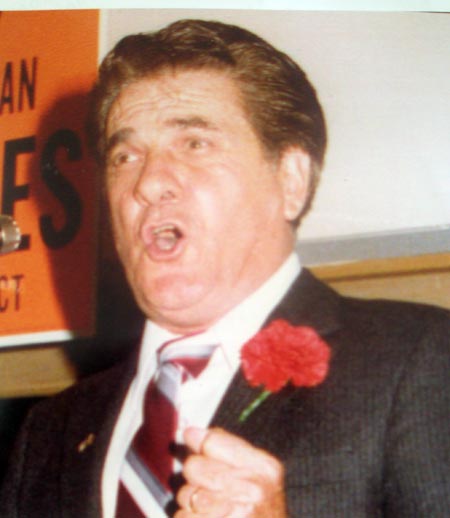 A recording of Rocco Scotti singing the National Anthem.
A recording of Rocco Scotti singing the National Anthem.
Rocco grew up in Little Italy, the Cleveland son of Italian immigrants. He grew up working in construction, thinking he would one day be an artist. He dabbled in acting, and took singing lessons. In 1942, before the Tribe hosted a game with the Baltimore Orioles, Scotti sang the Anthem. He’d sung it at the Stadium a few times prior, but on this day, he sang with gusto. It was the first time he sang the ending in his signature manner: “O’er the land of the freeeeeee, and the home of the------ (in a crescendo, hitting "the" on the same note as “freeeeee” and falling back down to- ) braaaaaaave!!!!” The story goes that the Orioles got so fired up over his rendition that several of them ran out on the field to greet Scotti. He became a regular guest singer of the Anthem for the Indians into the 1990s.
We should be able to get a video of Rocco at the stadium. Maybe a video montage from down through the years. We’ll digitally enhance one of his recordings and ba-da binggg.
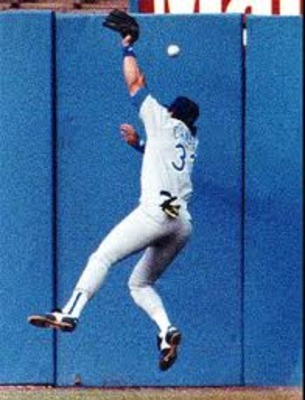 Jose Canseco’s hat.
Jose Canseco’s hat.
You know the one. Blue, Texas Ranger hat, 1993 vintage. It may have a mark on it- one that a batted ball might have made.
During a game in that final Indians season on the lakefront, Rangers pitcher Kenny Rogers induced designated hitter Carlos Martinez to hit a fly ball to right field. Canseco ranged to his right near the wall to make the catch- he raised his glove and the ball ticked it. It caromed off his head, back up into the air, and OVER THE WALL! The center fielder stood with the incredulous Canseco, who rubbed his head a little and seemed to seek confirmation that the actual 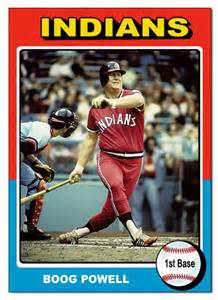 result was a home run. Later, Canseco would comment that he really didn’t feel the ball strike him. After sneaking as nonchalant a peek at Canseco as he could muster, Martinez jogged around the bases with his head down.
result was a home run. Later, Canseco would comment that he really didn’t feel the ball strike him. After sneaking as nonchalant a peek at Canseco as he could muster, Martinez jogged around the bases with his head down.
The mid 1970s all-red uniform.
Obviously, the appeal here is not to pretend it was a good look. In fact, it was most memorable on the ballplayers who looked the most awkward in it. Boog Powell, we are looking at you. Boog said he felt like a “giant tomato”. Perfect. (This was not an actual Topps card. It was a photoshopped to look like one. But I like it.)
Karl Wallenda’s pole, from the day he walked the tightrope over Cleveland Stadium.
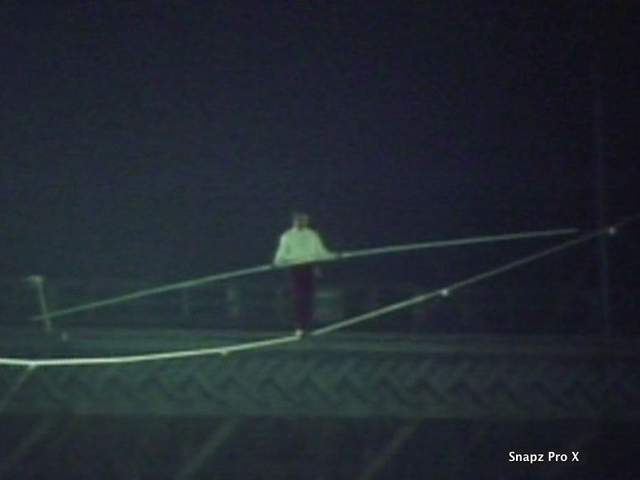 Just prior to a 69 year old Wallenda performing the 1975 feat, the Tribe had dropped a 4-2 decision to the Kansas City Royals. Before the game, Wallenda had helped to rig the rope from the roof on the third base side, to the roof on the third base side. His trip across was at once tense and uneventful. The 15,000 – plus on hand cheered in relief. He and his family did this type of stuff all the time- until his death in Miami a few years later, amid windy conditions and faulty connections.
Just prior to a 69 year old Wallenda performing the 1975 feat, the Tribe had dropped a 4-2 decision to the Kansas City Royals. Before the game, Wallenda had helped to rig the rope from the roof on the third base side, to the roof on the third base side. His trip across was at once tense and uneventful. The 15,000 – plus on hand cheered in relief. He and his family did this type of stuff all the time- until his death in Miami a few years later, amid windy conditions and faulty connections.
For the Royals that day, a Vada Pinson pop fly hit the rope, falling into left field for a single. Hal McRae, who had been on first, tried to advance to third base on the fluke single and was thrown out by shortstop Frank Duffy. This was all pretty thrilling stuff for, say, a 14 year old kid…
A booth from The Theatrical, the bar near the Stadium on Short Vincent.
I have an ongoing curiosity about this place, a popular yet somewhat shadowy watering hole from the past. It was 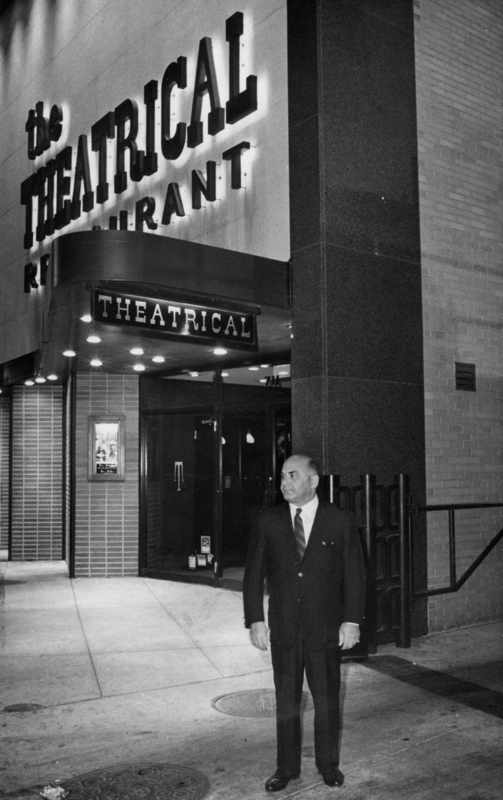 where news on the street was exchanged. Visiting ballclubs frequented the place (George Steinbrenner kept a tab), and regulars had “their” own tables.
where news on the street was exchanged. Visiting ballclubs frequented the place (George Steinbrenner kept a tab), and regulars had “their” own tables.
In 1974, Frank Robinson was signed by the Indians toward the end of the season. On the day he joined the team, Gaylord Perry publicly stated he wanted to be paid “one dollar more” than Robinson. Robinson took the bait, and the two engaged in a shouting match during a rain delay. Manager Ken Aspromonte emerged from his office, and the shouting subsided. Aspro announced that he was stepping down as manager.
Robinson’s agent was in negotiations with Tribe brass to be the Indians’ manager in 1975. All parties denied this at the time. When talks got serious, the deal was consummated at The Theatrical- coincidentally, at Ken Aspromonte’s table.
I want the booth, and perhaps the sign on the façade of the building.
Cleveland Indians scorecard from 6/26/1916. And left fielder Jack Graney’s uniform that day.
On this date, the Tribe became the first big league team to experiment with wearing uniform numbers. Numbers were pinned to their uniform sleeves, and corresponded to the numbers listed on the scorecard. (Heck, I’d love even photos of these items.)
This museum would have a special wing, devoted to Bill Veeck.
Veeck, who had served in a Marines artillery unit and lost a leg due to a wound sustained in World War II, had owned a minor league ball club in Milwaukee, where he was known to engage in publicity stunts.
He was in line to purchase the Philadelphia Phillies in 1942. His plan was to stock the team entirely with black players. He miscalculated in making his intentions public. His thinking was that commissioner Kennesaw Mountain Landis would allow this to occur. Instead, Landis transferred control of the franchise to the National League until another owner could be found.
Veeck bought the Cleveland Indians in 1946. Tribe games were immediately aired on radio.
We need some radio broadcast recordings from 1946.
Veeck moved the Indians from League Park to Cleveland Stadium on a permanent basis as of 1947.
Veeck integrated the Indians, signing Larry Doby (left) in 1947 to become the first black American League ballplayer. He promptly rid the roster of the three 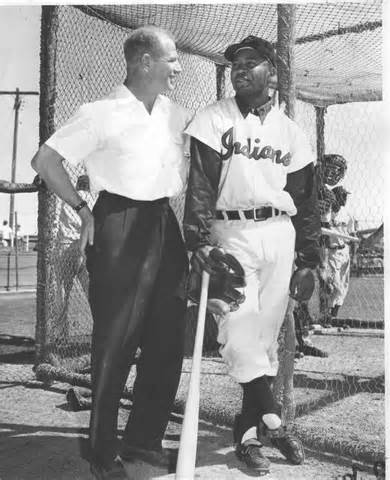
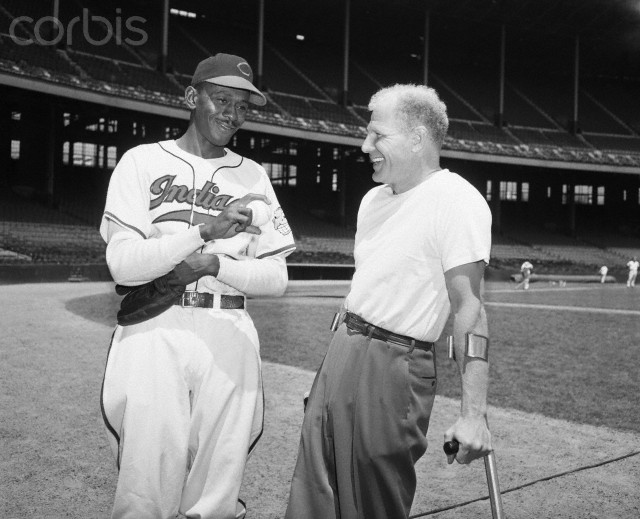 ballplayers who refused to shake Doby’s hand when he was introduced.
ballplayers who refused to shake Doby’s hand when he was introduced.
During the 1948 season, Veeck signed old veteran Satchel Paige (right) to help the Indians win the AL pennant.
We need a 1947 jersey of Larry Doby, and a 1948 jersey of Satchel Paige.
Veeck hired a baseball comic, Max Patkin, to coach first base. Patkin’s humor was basically the same as that of major league baseball mascots of today. Fans loved it, and the league hated it.
The Indians won the 1948 World Series. In 1949, they were eliminated from the pennant race. (Ever the showman, Veeck had staged a season reset. A do-over: he held another Opening Day, midseason. Ceremonial flag-raising; marching bands; a speech by the mayor.) Veeck held a funeral behind the center field fence, with a hearse. A minister said some words (reciting The Sporting News, baseball's "Bible"); Veeck made a show of wiping his eyes with his large white handkerchief, and the 1948 pennant was buried (carefully, and removed later).
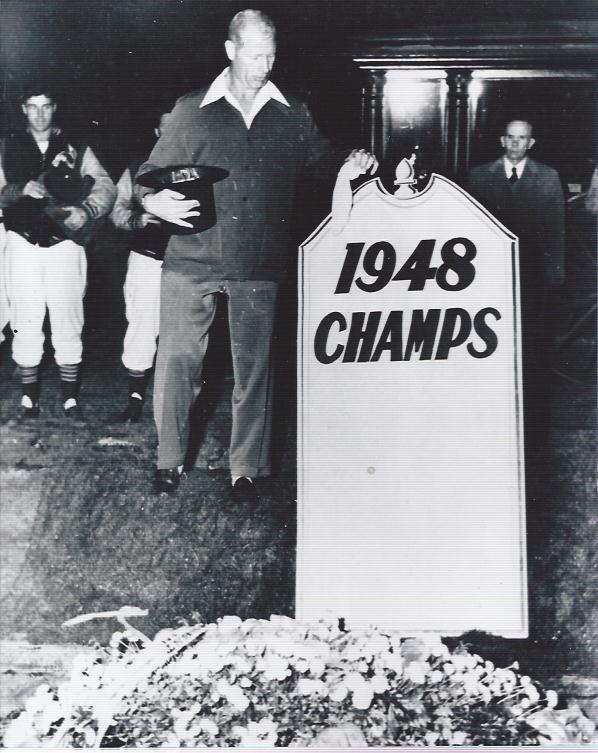 We’ll take the pennant. And the pennant’s ‘headstone.’
We’ll take the pennant. And the pennant’s ‘headstone.’
A fan, Charlie Lupica, built a perch on a flag pole, vowing he would not come down until the Indians were back in first place. Days turned into weeks, and then months. In late September, they were mathematically eliminated. In the meantime, Lupica’s wife – whom had been sending meals up to Charlie- bore their fourth child! Veeck covered the bills. Various businesses donated items to assist Charlie with his stay on his perch.
A couple days after the 1949 ‘funeral’, Bill Veeck made a big show of bringing Charlie Lupica down from his perch. The entire setup was slowly moved a few miles, to the Stadium. With his wife and (now four) children waiting, Charlie descended down a ladder to the cheering of the baseball crowd. Veeck awarded him with various nice household gifts, a new car- and a 50ft flagpole for his store.
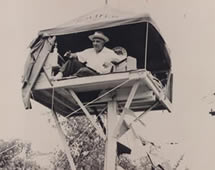 We need Charlie Lupica’s perch.
We need Charlie Lupica’s perch.
Veeck divorced later in 1949, and was forced to liquidate the Cleveland Indians in order to pay the court-ordered settlement. His legacy continued with subsequent ownership of the St. Louis Browns.
To be continued, sometime down the road…
Sources included Clevelandseniors.com, Wikipedia.
- NBA Announces 2013-2014 Schedule
- Browns Ink Sharknado
- Sharknado A No-Show For Rookie Camp
- Trent Richardson Out Until Training Camp
- Browns Sign Brandon Jackson
- Carrasco Suspended Eight Games
- Browns Add to Wide Receiver Depth with David Nelson
- Browns Need to Learn from Past Draft Mistakes
- Browns Release Chris Gocong and Usama Young
- Browns Missing on Grimes Disappointing, But Not The End
The TCF Forums
- Chris Grant's first 3 drafts
Kingpin74 (Tuesday, January 21 2014 10:13 AM) - The 2014 Offseason Thread
googleeph2 (Tuesday, January 21 2014 9:36 AM) - 2015 Recruiting
furls (Tuesday, January 21 2014 6:57 AM) - Mike Brown
YahooFanChicago (Monday, January 20 2014 11:15 PM) - Movies coming out
HoodooMan (Monday, January 20 2014 9:34 PM) - 2014 Hoops Hockey Hijinx
jpd1224 (Monday, January 20 2014 4:44 PM) - 2014 Recruiting
jclvd_23 (Monday, January 20 2014 2:26 PM) - Wish List - #4 Pick
Hikohadon (Monday, January 20 2014 1:26 PM) - Official- Browns Coach Search/Rumors
OldDawg (Sunday, January 19 2014 6:48 PM) - #1 overall pick Anthony Bennett
TouchEmAllTime (Sunday, January 19 2014 1:28 PM)



